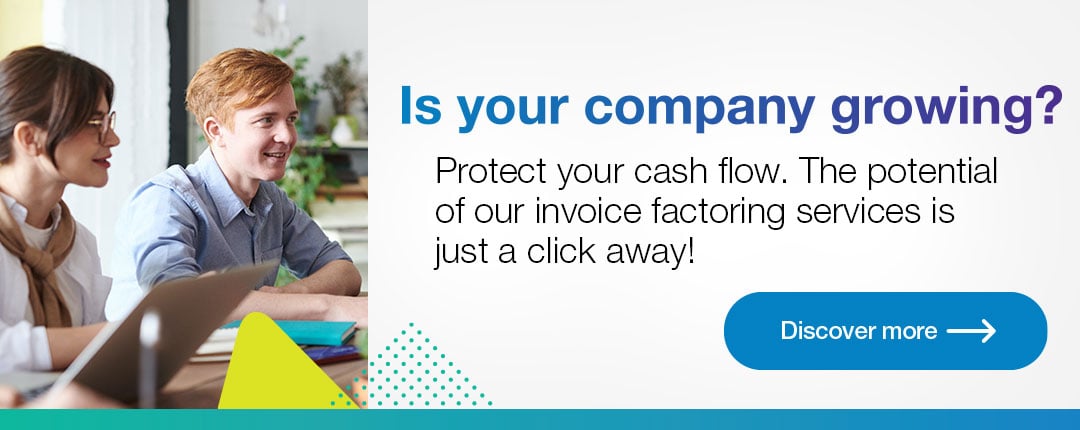
Purchase Order Financing (PO financing or PO lending) can be of enormous importance and benefit to a small business or startup when cash flow is a primary consideration. It can subsidize a company's funding challenges during periods of growth or seasonality while offering breathing room and investment opportunities. It pairs well with factoring, the process of selling your invoices with paying terms to receive cash right away.
What is PO finance?
Purchase Order Financing (PO financing) is a funding program that consists of an advance from a financing company against a Purchase Order (PO) value. Qualified orders involve standard, finished products purchased by business-to-business (B2B) or business-to-government (B2G) clients. It helps stabilize cash flow with access to working capital to buy raw materials so you can fulfill the order.
How does it work?
Purchase Order Financing (PO financing) is a simple process.
- You receive a Purchase Order (PO) from your client.
- You receive a proposal from your supplier, with costs for the order.
- With the PO in hand, as well as the supplier's proposal, you apply for PO financing (and are approved).
- The PO financing company advances the funds to your supplier so they can deliver the products to the client.
- When the customer receives/accepts the order, they pay the financing company.
- The lender (finance company) deducts their fees, and the amount advanced to your supplier.
- You receive the remaining balance.
PO financing is just a way to finance purchasing from your supplier. Since it covers manufacturing and shipping/transportation for standard products, your cash flow remains unaffected while you fulfill the client's order. This asset-based support is essential when your sales cycle is far outpacing your ability to fulfill orders. Instead of turning clients away, you're developing alternate opportunities or streams for fulfillment.
Learn more: How Many Businesses Fail in the First 2 Years?
Pros and Cons of Purchase Order Financing
As with any financing option, there are advantages and disadvantages to the use of Purchase Order Financing (PO financing). Here are just a few of the Pros:
- Easy access: From a business perspective, a PO financing situation gives you ready access to working capital, so your company can grow without selling equity or incurring bank debt. It's easy to set up, and PO financing options are often available to small businesses and startups. Creditworthiness is usually determined by your suppliers and customers. As long as you have strong business relationships, you should be able to offer this flexible solution.
- No installments: The payment is often made all at once to the supplier, although it can be just a portion of the order's entire value. PO financing can also cover shipping/transportation costs, which helps defray all upfront costs you incur. Ultimately, it's important because you don't have to wait for monthly installments.
- Better than credit cards: After fees, credit cards can be a more expensive form of payment for your company, so PO financing can be better and cheaper for a company to use. Your credit line is based on the number of Purchase Orders you generate. The rates can range from 1.15% to 6%.
- No collection hassle or risk: Unlike a bank loan, you're not responsible for the annoyance, inconvenience, expense, or risk of collecting the payments/installments from the client. That headache and responsibility will be on the shoulders of the financing company. But you have to make sure the financing company will handle the collection process in a way that improves, instead of adversely affects, your client's experience with your company.
PO Financing sounds like a great deal, and it can be. Unfortunately, there are some reasons why it could be problematic for your company as well.
And these are the cons:
- Less than the full amount: The lender or factor retains a portion (typically 20%) of the total amount until the complete purchase order, including interest, is fully paid back. That means that you incur finance costs during the time it takes the supplier to fulfill the order and then the time it takes the customer to pay for the products.
- Upfront cost: The financing company charges you a fee for the advanced funds. The rates can range from 1.15% to 6%, with the lower rates typically available for larger transaction amounts. Your credit line size depends on how many invoices/POs you generate, not your profitability or creditworthiness. Financing companies prefer a 15-30% margin so that there's theoretically enough room for everyone to make a profit on the transaction. They also prefer transactions that exceed $50,000.
- Limited: PO financing usually only applies to standard (tangible) purchases. It's not generally applicable for situations where the client requires customizations or installation services. That's also why resellers, distributors, wholesalers, and other types of outsourcing manufacturers are the companies most often able to take advantage of PO financing.
Purchase Order Financing (PO financing) may be the best solution for your company, as it offers flexibility and growth opportunities for small businesses and startups. It can help relieve the pressure of upfront costs and tapped-out credit lines without resorting to expensive loans or other financing options. It's a great short-term solution for cash-flow problems while allowing your business to fulfill large orders.
At Summar, we offer you custom solutions, so your operation never stops, neither your growth goals. We are the financing experts that your company needs! Our PO financing service, available exclusively to our factoring clients, will allow you to fulfill all your orders, no matter how large, the easy, fast way. Contact us for more information.

